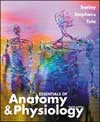 |  Essentials of Anatomy & Physiology, 4/e Rod R. Seeley,
Idaho State University
Philip Tate,
Phoenix College
Trent D. Stephens,
Idaho State University
The Nervous System
Study OutlineFunctions of the Nervous System
Sensory input
Integration
Homeostasis
Mental activity
Control of skeletal muscle
Divisions of the Nervous System(Fig. 8.1, p.194, Fig. 8.2, p. 195)Central nervous system (CNS)Clinical Focus: Central Nervous
System Disordersp. 222-223
Peripheral nervous system (PNS)Clinical Focus: Peripheral Nervous
System Disordersp. 230
Afferent division
Efferent division
Somatic nervous system
Autonomic nervous system
Parasympathetic nervous system
Sympathetic nervous system
Cells of the Nervous System(Table 8.1, p. 197)Neurons
Structure(Fig. 8.3, p. 196)Cell body
Dendrites
Axons and collateral axons
Myelin sheath
Function
Sensory
Motor
Association
Types(Fig. 8.4, p. 197)Unipolar
Bipolar
Multipolar
Neuroglia(Fig. 8.5, p. 199)Astrocytes
Ependymal cells
Microglia
Oligodendrocytes
Schwann cells
Myelin Sheaths(Fig. 8.6, p. 200)Organization of nervous tissue
Propagation of Action Potentials
Resting membrane potential(Fig. 8.7, p. 200)Changes in membrane potential(Fig. 8.8, Fig. 8.9, p. 201)Action potential(Fig. 8.10, p. 202)All-or-none characteristic
Saltatory conduction(Fig. 8.11, p. 202) The Synapse(Fig. 8.12, p. 203)Synaptic cleft
Neurotransmitters
Acetylcholine
Norepinephrine
Reflexes-reflex arc(Fig. 8.13, p. 204)Knee-jerk reflex(Fig. 8.14, p. 205)Withdrawal reflex(Fig. 8.15, p. 206) Neuronal circuits
Convergent circuits(Fig. 8.16, p. 206)Divergent circuits(Fig. 8.17, p. 207) Central Nervous System - Brain(Fig. 8.18, p. 208)Brainstem(Fig. 8.19, p. 208)Medulla oblongata
Pons
Midbrain
Reticular formation
Diencephalon(Fig. 8.20, p. 210)Thalamus
Epithalamus
Hypothalamus
Cerebrum(Fig. 8.21, p. 210)Fissures
Gyri and sulci
Lobes
Frontal lobe
Parietal lobe
Occipital lobe
Temporal lobe
Functional areas of the cerebral cortex(Fig. 8.22, p. 212)Primary somatic sensory cortex
Association areas
Motor areas
Primary motor cortex
Premotor area
Prefrontal area
Speech
Brainwaves(Fig. 8.23, p. 213)Memory
Right and left cerebral hemispheres
Basal nuclei(Fig. 8.24, p. 214)Limbic system(Fig. 8.25, p. 215) Cerebellum(Fig. 8.26, p. 216)Spinal cord(Fig. 8.27, p. 216, Tbl. 8.2, p. 217)Ascending pathways(Fig. 8.28, p. 217)Descending pathways(Fig. 8.29, p. 218) Meninges(Fig. 8.30, p. 219)Ventricles(Fig. 8.31, p. 220)Cerebrospinal fluid(Fig. 8.32, p. 221) Peripheral Nervous System
Cranial nerves-(12 pr.)(Fig. 8.33, Tbl. 8.3, p. 224)Spinal nerves-(31 pr.)(Fig. 8.34, p. 226, Tbl. 8.4, p. 225)Cervical plexus
Brachial plexus
Lumbosacral plexus
Autonomic Nervous System(Fig. 8.36, p. 228, Tbl. 8.5, p. 229)General characteristics
Sympathetic division
Parasympathetic division
Autonomic neurotransmitters
Systems Pathology - StrokeSystems Interaction Tablep. 232
|
|



 2002 McGraw-Hill Higher Education
2002 McGraw-Hill Higher Education